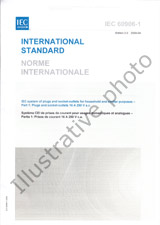We need your consent to use the individual data so that you can see information about your interests, among other things. Click "OK" to give your consent.

IEC 63305-ed.1.0
Underwater acoustics - Calibration of acoustic wave vector receivers in the frequency range 5 Hz to 10 kHz
Translate name
STANDARD published on 27.2.2024
The information about the standard:
Designation standards: IEC 63305-ed.1.0
Publication date standards: 27.2.2024
SKU: NS-1168238
The number of pages: 126
Approximate weight : 409 g (0.90 lbs)
Country: International technical standard
Category: Technical standards IEC
The category - similar standards:
Annotation of standard text IEC 63305-ed.1.0 :
IEC 63305:2024 specifies methods and procedures for calibration of vector receivers in the frequency range 5 Hz to 10 kHz, which are applicable to vector receivers based on the two different principles. In addition, it describes an absolute method of inertial vector receiver calibration in air using optical interferometry. Usually, acoustic wave vector receivers are designed and constructed based on one of two principles. One is the sound pressure difference (gradient) principle. When measuring with this sensor, the vector receiver is rigidly fixed on a mount and supported in water. The other is the co-vibrating (inertial) principle. When measuring with this sensor, the vector receiver is suspended on a mount and supported in water in a non-rigid manner, which allows the vector receiver co-vibrate in the same direction as the sound particle in the sound wave field. Many methods have been used to calibrate vector receivers, such as free-field calibration, calibration in standing wave tube and calibration in a travelling wave tube. LIEC 63305:2024 specifie les methodes et procedures d’etalonnage des recepteurs vectoriels dans la plage de frequences de 5 Hz a 10 kHz, qui sont applicables aux recepteurs vectoriels sur la base de deux principes differents. En outre, il decrit une methode absolue d’etalonnage des recepteurs vectoriels inertiels dans l’air a l’aide de l’interferometrie optique. En general, les recepteurs vectoriels d’ondes acoustiques sont concus et construits sur la base de l’un des deux principes suivants. L’un reside sur le principe de la difference de pression acoustique (gradient). Lors du mesurage avec ce capteur, le recepteur vectoriel est fixe de maniere rigide sur un support et soutenu dans leau. L’autre principe repose sur la co-vibration (inertie). Lors du mesurage avec ce capteur, le recepteur vectoriel est suspendu a un support et soutenu dans leau de maniere non rigide, ce qui permet une co-vibration de ce dernier dans la meme direction que la particule acoustique dans le champ dondes acoustiques. De nombreuses methodes ont ete appliquees pour etalonner les recepteurs vectoriels, telles que l’etalonnage en champ libre, l’etalonnage dans un tube a ondes stationnaires et l’etalonnage dans un tube a ondes progressives
We recommend:
Technical standards updating
Do you want to make sure you use only the valid technical standards?
We can offer you a solution which will provide you a monthly overview concerning the updating of standards which you use.
Would you like to know more? Look at this page.



 Cookies
Cookies
